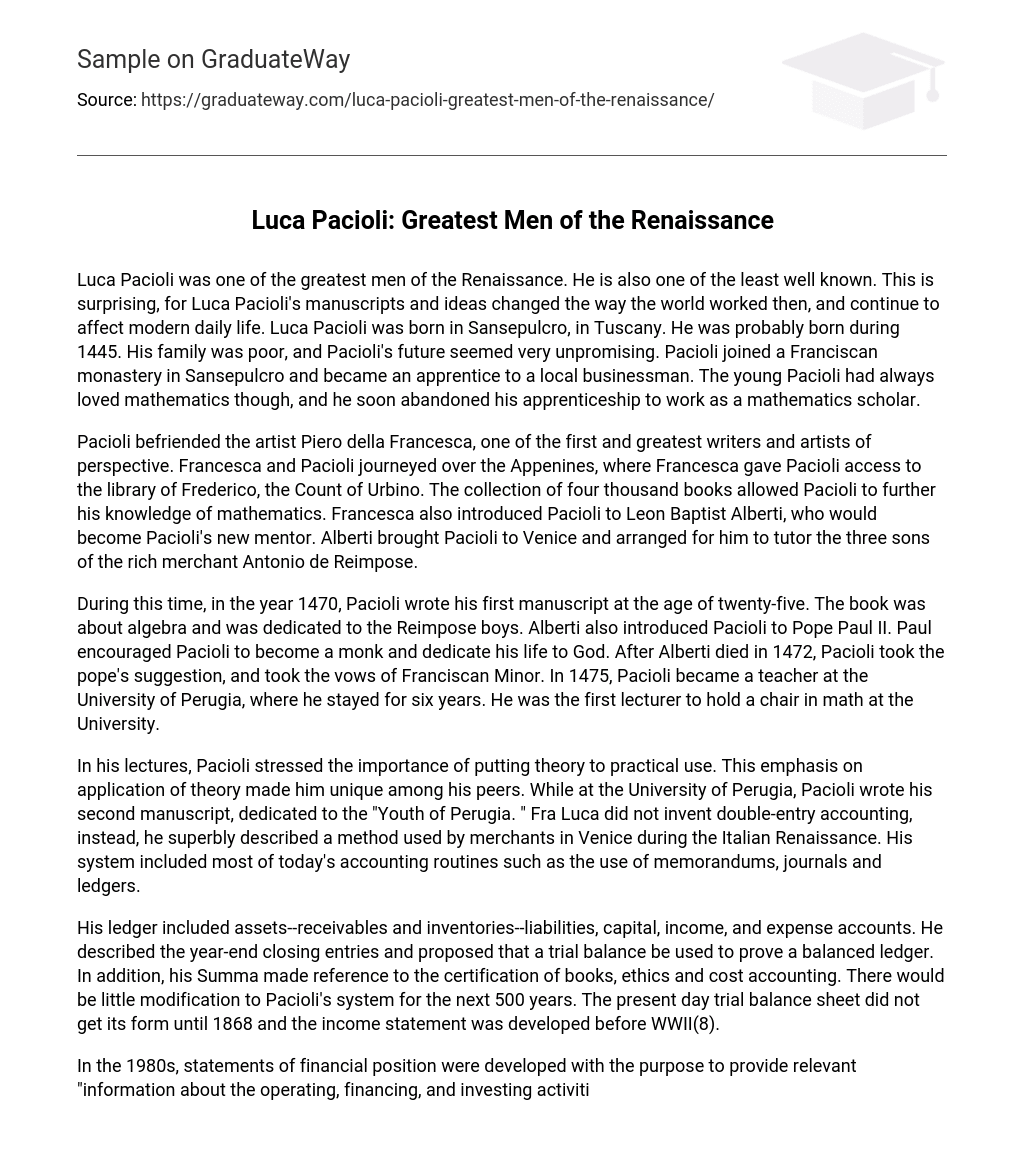Luca Pacioli was one of the greatest men of the Renaissance. He is also one of the least well known. This is surprising, for Luca Pacioli’s manuscripts and ideas changed the way the world worked then, and continue to affect modern daily life. Luca Pacioli was born in Sansepulcro, in Tuscany. He was probably born during 1445. His family was poor, and Pacioli’s future seemed very unpromising. Pacioli joined a Franciscan monastery in Sansepulcro and became an apprentice to a local businessman. The young Pacioli had always loved mathematics though, and he soon abandoned his apprenticeship to work as a mathematics scholar.
Pacioli befriended the artist Piero della Francesca, one of the first and greatest writers and artists of perspective. Francesca and Pacioli journeyed over the Appenines, where Francesca gave Pacioli access to the library of Frederico, the Count of Urbino. The collection of four thousand books allowed Pacioli to further his knowledge of mathematics. Francesca also introduced Pacioli to Leon Baptist Alberti, who would become Pacioli’s new mentor. Alberti brought Pacioli to Venice and arranged for him to tutor the three sons of the rich merchant Antonio de Reimpose.
During this time, in the year 1470, Pacioli wrote his first manuscript at the age of twenty-five. The book was about algebra and was dedicated to the Reimpose boys. Alberti also introduced Pacioli to Pope Paul II. Paul encouraged Pacioli to become a monk and dedicate his life to God. After Alberti died in 1472, Pacioli took the pope’s suggestion, and took the vows of Franciscan Minor. In 1475, Pacioli became a teacher at the University of Perugia, where he stayed for six years. He was the first lecturer to hold a chair in math at the University.
In his lectures, Pacioli stressed the importance of putting theory to practical use. This emphasis on application of theory made him unique among his peers. While at the University of Perugia, Pacioli wrote his second manuscript, dedicated to the “Youth of Perugia. ” Fra Luca did not invent double-entry accounting, instead, he superbly described a method used by merchants in Venice during the Italian Renaissance. His system included most of today’s accounting routines such as the use of memorandums, journals and ledgers.
His ledger included assets–receivables and inventories–liabilities, capital, income, and expense accounts. He described the year-end closing entries and proposed that a trial balance be used to prove a balanced ledger. In addition, his Summa made reference to the certification of books, ethics and cost accounting. There would be little modification to Pacioli’s system for the next 500 years. The present day trial balance sheet did not get its form until 1868 and the income statement was developed before WWII(8).
In the 1980s, statements of financial position were developed with the purpose to provide relevant “information about the operating, financing, and investing activities of an enterprise and the effects of those activities on cash resources” Evolution Accounting Accounting has been called as the language of business. Accounting is the system which measures business activities. It processes activities in business into reports and communicates the results to top management. Let us now look through the advancement of accounting. Ancient Accounting
As early as 8500 B. C. , accounting has already existed. Archaeologists have found clay tokens as old as 8500 B. C. found in Mesopotamia which were usually cones, disks, spheres and pellets. These tokens correspond to such commodities like sheep, clothing or bread. They were used in the Middle West in keeping records. After some time, the tokens were replaced by wet clay tablets. During such time, experts concluded this to be the starts of the art of writing. Examples of ancient civilizations keeping account records are China, Babylonia, Greece and Egypt.
Like in Babylonia during 3600 B. C. , payments of salaries were recorded in clay tablets. In addition, the rulers of these civilizations keep track of labor and material costs used in building structures using accounting. A good example is the case of the Egyptian pharaohs in building their magnificent pyramids. Middle Ages During the thirteenth to the fifteenth centuries, trade flourished places such as Florence, Venice and Genoa, thus, there was advancement in account keeping methods, thanks to the merchants and the bankers of such time. uring the 1211 A. D. , one of the systems in accounting was kept by a Florentine banker. However, the system was primitive as the concept of equality for entries was absent. Double entry records first came out during 1340 A. D. in Genoa. In 1494, the first systematic record keeping was formulated by Fra Luca Pacioli, a Franciscan monk and one of the most celebrated mathematicians to this day. Pacioli is considered as the father of accounting.





